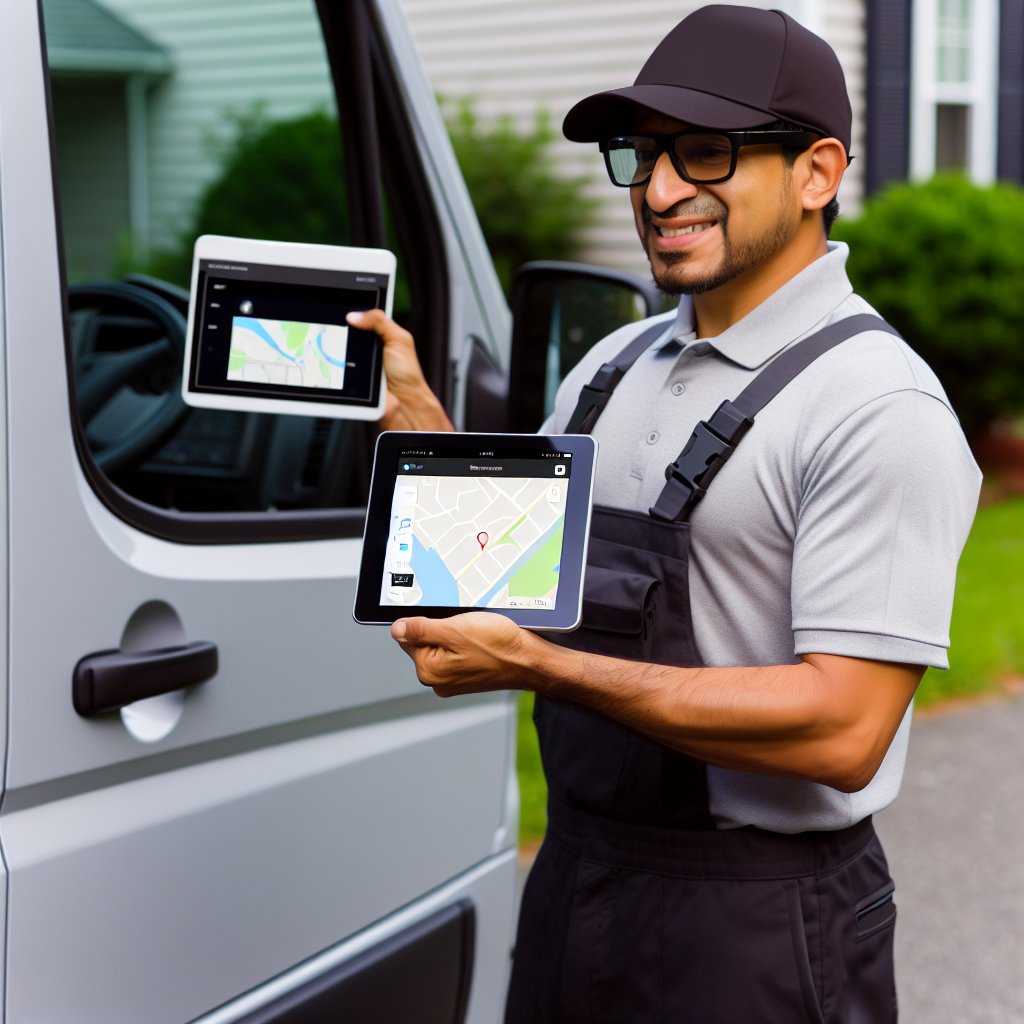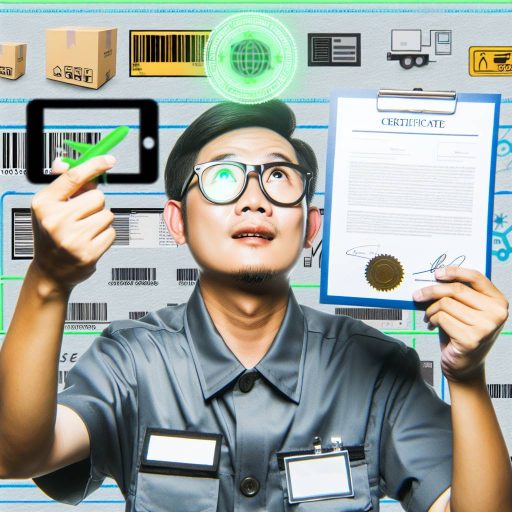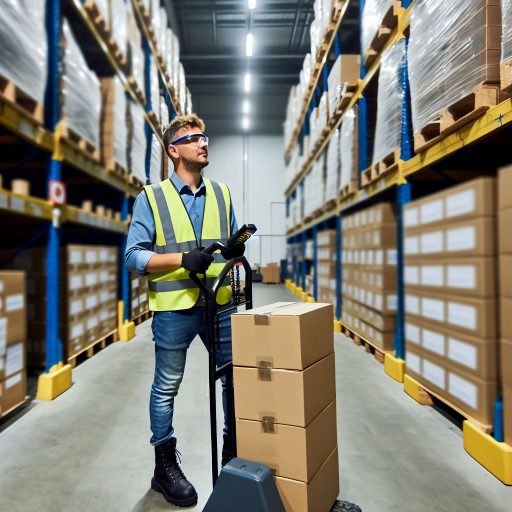Introduction:
A delivery driver is responsible for transporting goods from one location to another efficiently.
In recent years, technology has played an increasingly vital role in the delivery driver industry, revolutionizing the way these professionals work.
The impact of technology on delivery driver jobs has been significant, affecting various aspects of the role and transforming the way deliveries are managed and executed.
Increased Efficiency and Accuracy:
Technology has enabled delivery drivers to optimize their routes, leading to quicker and more efficient deliveries.
GPS systems and route optimization software help drivers avoid traffic and find the fastest route to their destination.
Enhanced Communication:
With the advent of smartphones and mobile applications, delivery drivers can now easily communicate with customers and dispatchers in real-time.
This has improved communication and coordination, leading to smoother delivery operations.
Automated Tracking and Monitoring:
Technology allows for real-time tracking and monitoring of deliveries, providing customers with accurate updates on the status of their orders.
This transparency has enhanced customer satisfaction and trust in delivery services.
Integration of Delivery Management Systems:
Many companies have implemented delivery management systems that streamline the entire delivery process, from order placement to final delivery.
These systems help optimize scheduling, route planning, and inventory management.
Shift Towards Automation:
Advancements in technology, such as autonomous vehicles and drones, have the potential to automate delivery services in the future.
While this may reduce the need for human delivery drivers, it could also create new job opportunities in related fields.
Evolution of Delivery Driver Jobs
Delivery driver jobs have evolved significantly over the years.
Advancements in technology are reshaping the industry.
Let’s take a closer look at the journey of delivery drivers from traditional methods to the introduction of technology and automation.
Traditional Methods of Delivery
- Decades ago, delivery driver jobs primarily involved using paper maps and handwritten directions to navigate deliveries.
- Drivers relied heavily on their knowledge of local streets and landmarks to efficiently reach their destinations.
- Communication with customers was limited to phone calls or in-person interactions upon delivery.
- Tracking packages and monitoring delivery status was a manual and time-consuming process.
Introduction of Technology in the Industry
- With the advent of GPS technology, delivery drivers could navigate more easily and accurately, reducing delivery times.
- Companies began implementing route optimization software to streamline delivery routes and improve efficiency.
- Mobile devices and smartphones became essential tools for delivery drivers, allowing for real-time communication and updates.
- Barcode scanning technology revolutionized package tracking, providing customers with instant updates on their deliveries.
Shift Towards Digital Platforms and Automation
- Today, delivery driver jobs increasingly rely on digital platforms and automation to manage deliveries and provide an enhanced customer experience.
- Many companies have adopted delivery tracking apps that allow customers to track their orders in real-time and receive notifications on delivery status.
- Automation tools such as drones and autonomous vehicles are being tested for delivery services, promising faster and more efficient deliveries in the future.
- Artificial intelligence and machine learning are being used to predict delivery times more accurately and optimize routes based on traffic and weather conditions.
The impact of technology on delivery driver jobs has been profound.
It has led to increased efficiency, accuracy, and speed in the delivery process.
As technology continues to advance, delivery drivers will need to adapt to new tools and platforms to meet the evolving demands of the industry.
Technology has revolutionized delivery driver jobs.
Transform Your Career Today
Unlock a personalized career strategy that drives real results. Get tailored advice and a roadmap designed just for you.
Start NowIt has led to increased efficiency and speed in deliveries.
Efficiency and Speed
- Technology has significantly improved delivery times through route optimization and real-time tracking.
- Customers now expect faster delivery times due to the convenience technology offers.
- Traditional delivery processes were slower and less accurate compared to technology-driven systems.
- With GPS tracking and automated systems, delivery drivers can avoid traffic and find the fastest routes.
- Real-time alerts and updates keep customers informed, leading to higher satisfaction levels.
- Technology-driven deliveries are more reliable and precise, meeting customers’ expectations more effectively.
- Traditional methods often relied on manual processes, resulting in delays and errors in deliveries.
Technology has played a crucial role in enhancing the efficiency and speed of delivery driver jobs.
It benefits both drivers and customers alike.
Discover More: Tools and Software for Supply Chain Analysts
Tracking and monitoring:
Tracking and monitoring technologies have revolutionized the delivery driver job sector.
They provide real-time data and insights that can improve efficiency and customer satisfaction.
Use of GPS and telematics in delivery vehicles
GPS technology has become a standard feature in delivery vehicles.
This allows companies to track their drivers’ routes, speed, and location.
Telematics systems gather data on vehicle performance, fuel consumption, and driver behavior.
This provides valuable insights for optimization.
Benefits of real-time tracking for companies and customers
Real-time tracking enables companies to monitor delivery progress.
They can adjust routes for efficiency and provide customers with accurate delivery estimates.
This transparency instills trust and improves customer satisfaction.
It often leads to repeat business.
Accountability and transparency in the delivery process
With tracking and monitoring tools, companies can hold drivers accountable for their actions.
This ensures timely deliveries and adherence to safety protocols.
Customers can also track their orders.
This reduces the risk of lost or delayed packages.
The integration of GPS and telematics in delivery driver jobs has significantly improved operational efficiency.
It has also enhanced customer service and overall job performance.
Transform Your Career Today
Unlock a personalized career strategy that drives real results. Get tailored advice and a roadmap designed just for you.
Start NowEmbracing these technologies is essential for staying competitive in the modern delivery industry.
Discover More: Essential Qualities of Successful Rail Yard Engineers
Data analytics and optimization:
In the age of technology, data analytics plays a crucial role in the efficiency and effectiveness of delivery driver jobs.
Let’s explore how data analytics and optimization are transforming the delivery industry.
Collection of data on delivery routes and performance
Gone are the days when delivery drivers relied solely on their instincts to navigate through routes.
With the help of GPS tracking and route optimization software, companies can now collect real-time data on delivery routes and driver performance.
This data includes information on traffic patterns, delivery times, and driver behavior.
Use of data to optimize delivery schedules
By analyzing the data collected on delivery routes and performance, companies can optimize delivery schedules to improve efficiency and reduce costs.
For example, based on historical data, companies can identify peak delivery times and allocate resources accordingly.
This not only helps in meeting customer expectations but also minimizes fuel consumption and wear and tear on vehicles.
Predictive analytics for demand forecasting and resource allocation
Predictive analytics has revolutionized the way companies forecast demand and allocate resources for delivery operations.
By analyzing historical data and market trends, companies can predict future demand with a high degree of accuracy.
This enables companies to proactively adjust their delivery schedules and allocate resources to meet customer needs effectively.
Gain More Insights: Expediter’s Guide to Effective Resource Allocation
Training and skill requirements:
Delivery drivers need to be tech-savvy to keep up with advancements.
Training programs are essential to help drivers adapt to new technologies.
The impact on job requirements and skill sets is significant in the industry.
With the rapid evolution of technology, the role of delivery drivers has seen significant changes in recent years.
As delivery services become more reliant on technology for operations, it is crucial for delivery drivers to be tech-savvy to navigate the new landscape effectively.
Training programs play a vital role in helping delivery drivers adapt to these new technologies.
Transform Your Career Today
Unlock a personalized career strategy that drives real results. Get tailored advice and a roadmap designed just for you.
Start NowCompanies now offer specialized training to equip drivers with the necessary skills to utilize GPS navigation, routing apps, and other high-tech tools efficiently.
The impact on job requirements and skill sets is evident in the modern delivery driver role.
In addition to the traditional responsibilities of driving and delivering packages, drivers are now expected to possess proficiency in using electronic devices and software to streamline their tasks.
As technology continues to advance, the demand for tech-savvy delivery drivers will only increase.
Companies are looking for individuals who can quickly learn and adapt to new technological innovations to enhance efficiency and customer satisfaction.
The shift towards technology-driven delivery operations emphasizes the need for delivery drivers to stay updated on the latest trends and tools.
By investing in training programs and upskilling, delivery drivers can secure their positions in the evolving job market.
Uncover the Details: Freight Agent Adaptation to Market Changes

Job security and automation:
- Concerns about the future of delivery driver jobs
- Potential for automation and driverless vehicles
- Mitigation strategies for job security in the industry
In today’s rapidly evolving technological landscape, the future of delivery driver jobs is a topic of concern among industry professionals and workers alike.
With the rise of automation and the development of driverless vehicles, there is a growing fear that traditional delivery driver roles may become obsolete in the near future.
As technology continues to advance, there is a real risk that delivery driver jobs could be replaced by autonomous vehicles and drones.
Companies like Amazon and UPS have already begun experimenting with drone delivery systems, raising questions about the future of human delivery drivers in the industry.
One of the main challenges facing delivery drivers is the potential for automation to streamline and optimize the delivery process.
While automation can increase efficiency and reduce costs for companies, it also poses a threat to job security for human workers who may be replaced by machines.
Concerns about the future of delivery driver jobs:
Delivery drivers are concerned about the impact of technology on their job security and livelihood.
With advancements in automation and artificial intelligence, there is a real risk that human delivery drivers could be replaced by autonomous vehicles and drones in the future.
Potential for automation and driverless vehicles:
The potential for automation in the delivery industry is significant, with companies like Amazon and UPS investing heavily in autonomous technology.
Driverless vehicles have the capacity to revolutionize the way goods are transported and delivered, posing a threat to traditional delivery driver jobs.
Mitigation strategies for job security in the industry:
To address concerns about job security in the face of automation, delivery drivers and industry stakeholders must proactively develop mitigation strategies.
These strategies may include upskilling and training programs to equip drivers with the skills needed to work alongside automated systems.
Transform Your Career Today
Unlock a personalized career strategy that drives real results. Get tailored advice and a roadmap designed just for you.
Start NowAdvocating for policies that protect the rights of human workers in the age of automation is also essential.
By acknowledging the potential impact of technology on delivery driver jobs and implementing proactive measures to safeguard against automation, the industry can work towards a future where both human workers and technology can coexist harmoniously.
This ensures efficient and reliable delivery services.
Environmental impact:
– Technology enables route optimization for delivery drivers, leading to increased fuel efficiency.
– With the help of technology, delivery companies can reduce their carbon footprint significantly.
– Sustainability practices are being incorporated into technology-driven delivery services to promote environmental responsibility.
– By leveraging advanced technology, delivery companies can cut down on unnecessary emissions and improve air quality.
– The use of electric vehicles and drones for deliveries further reduces the environmental impact of delivery operations.
– Technologies like GPS tracking and real-time monitoring help drivers avoid traffic congestion, reducing fuel consumption.
– Delivery companies that prioritize sustainability are investing in eco-friendly vehicles and packaging materials.
– Technology also enables the implementation of greener supply chain practices, leading to overall environmental benefits.
– In the long run, the adoption of technology in delivery driver jobs is expected to contribute to a cleaner and more sustainable environment.
Impact of Technology on Delivery Driver Jobs
Technology has revolutionized the delivery driver industry in recent years.
With the advent of GPS tracking and route optimization software, drivers can now work more efficiently.
Many companies have implemented technology to streamline operations.
This has led to increased productivity and faster delivery times.
As a result, there is a higher demand for delivery drivers who are tech-savvy.
Furthermore, the use of mobile apps has allowed drivers to receive real-time updates on orders.
They can communicate with customers more effectively, leading to improved customer satisfaction.
This also promotes repeat business.
Transform Your Career Today
Unlock a personalized career strategy that drives real results. Get tailored advice and a roadmap designed just for you.
Start NowHowever, technology has also brought challenges for delivery drivers.
Automation and autonomous vehicles threaten to replace human drivers in the future.
This poses a risk to job security.
Future Outlook of the Industry
As technology continues to advance, delivery driver jobs will likely evolve.
Companies may invest in autonomous delivery vehicles.
This investment could reduce the need for human drivers.
It is crucial for delivery drivers to adapt to these technological changes.
By upskilling and learning how to operate new systems, they can ensure competitiveness in the industry.
Call to Action
Companies and delivery drivers alike must embrace technology to stay relevant.
In the evolving delivery industry, investing in training and adopting new technologies is vital.
This will help secure their future in an increasingly tech-driven world.
Additional Resources
DHL Home – Global Logistics and International Shipping United …




